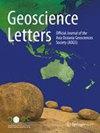The climate variability trio: stochastic fluctuations, El Niño, and the seasonal cycle
IF 4.3
3区 地球科学
Q1 GEOSCIENCES, MULTIDISCIPLINARY
引用次数: 0
Abstract
Abstract Climate variability has distinct spatial patterns with the strongest signal of sea surface temperature (SST) variance residing in the tropical Pacific. This interannual climate phenomenon, the El Niño-Southern Oscillation (ENSO), impacts weather patterns across the globe via atmospheric teleconnections. Pronounced SST variability, albeit of smaller amplitude, also exists in the other tropical basins as well as in the extratropical regions. To improve our physical understanding of internal climate variability across the global oceans, we here make the case for a conceptual model hierarchy that captures the essence of observed SST variability from subseasonal to decadal timescales. The building blocks consist of the classic stochastic climate model formulated by Klaus Hasselmann, a deterministic low-order model for ENSO variability, and the effect of the seasonal cycle on both of these models. This model hierarchy allows us to trace the impacts of seasonal processes on the statistics of observed and simulated climate variability. One of the important outcomes of ENSO’s interaction with the seasonal cycle is the generation of a frequency cascade leading to deterministic climate variability on a wide range of timescales, including the near-annual ENSO Combination Mode. Using the aforementioned building blocks, we arrive at a succinct conceptual model that delineates ENSO’s ubiquitous climate impacts and allows us to revisit ENSO’s observed statistical relationships with other coherent spatio-temporal patterns of climate variability—so called empirical modes of variability . We demonstrate the importance of correctly accounting for different seasonal phasing in the linear growth/damping rates of different climate phenomena, as well as the seasonal phasing of ENSO teleconnections and of atmospheric noise forcings. We discuss how previously some of ENSO’s relationships with other modes of variability have been misinterpreted due to non-intuitive seasonal cycle effects on both power spectra and lead/lag correlations. Furthermore, it is evident that ENSO’s impacts on climate variability outside the tropical Pacific are oftentimes larger than previously recognized and that accurately accounting for them has important implications. For instance, it has been shown that improved seasonal prediction skill can be achieved in the Indian Ocean by fully accounting for ENSO’s seasonally modulated and temporally integrated remote impacts. These results move us to refocus our attention to the tropical Pacific for understanding global patterns of climate variability and their predictability.气候变率三重奏:随机波动、El Niño和季节循环
气候变率具有明显的空间分布特征,其中热带太平洋海温变化信号最强。这种年际气候现象,即厄尔Niño-Southern涛动(ENSO),通过大气遥相关影响全球的天气模式。其他热带盆地和温带地区也存在明显的海温变率,尽管幅度较小。为了提高我们对全球海洋内部气候变率的物理理解,我们在这里提出了一个概念模式层次,该模式层次捕捉了观测到的从亚季节到年代际时间尺度的海温变率的本质。构建模块包括Klaus Hasselmann提出的经典随机气候模型,ENSO变率的确定性低阶模型,以及季节周期对这两个模型的影响。这种模式层次使我们能够追踪季节过程对观测到的和模拟的气候变率统计的影响。ENSO与季节周期相互作用的重要结果之一是产生频率级联,导致在大范围时间尺度上的确定性气候变率,包括近一年的ENSO组合模态。利用上述构建模块,我们得出了一个简洁的概念模型,该模型描绘了ENSO无处不在的气候影响,并允许我们重新审视ENSO观察到的与其他连贯的气候变化时空模式的统计关系,即所谓的变率经验模式。我们证明了在不同气候现象的线性增长/阻尼率中正确考虑不同季节相位的重要性,以及ENSO遥相关和大气噪声强迫的季节相位。我们讨论了以前ENSO与其他变率模式的一些关系是如何由于功率谱和领先/滞后相关性的非直观的季节周期影响而被误解的。此外,很明显,ENSO对热带太平洋以外气候变率的影响往往比以前认识到的要大,准确地计算这些影响具有重要意义。例如,已经表明,通过充分考虑ENSO的季节调制和时间综合的远程影响,可以提高印度洋的季节预测技能。这些结果促使我们将注意力重新集中到热带太平洋,以了解全球气候变化模式及其可预测性。
本文章由计算机程序翻译,如有差异,请以英文原文为准。
求助全文
约1分钟内获得全文
求助全文
来源期刊

Geoscience Letters
Earth and Planetary Sciences-General Earth and Planetary Sciences
CiteScore
4.90
自引率
2.50%
发文量
42
审稿时长
25 weeks
期刊介绍:
Geoscience Letters is the official journal of the Asia Oceania Geosciences Society, and a fully open access journal published under the SpringerOpen brand. The journal publishes original, innovative and timely research letter articles and concise reviews on studies of the Earth and its environment, the planetary and space sciences. Contributions reflect the eight scientific sections of the AOGS: Atmospheric Sciences, Biogeosciences, Hydrological Sciences, Interdisciplinary Geosciences, Ocean Sciences, Planetary Sciences, Solar and Terrestrial Sciences, and Solid Earth Sciences. Geoscience Letters focuses on cutting-edge fundamental and applied research in the broad field of the geosciences, including the applications of geoscience research to societal problems. This journal is Open Access, providing rapid electronic publication of high-quality, peer-reviewed scientific contributions.
 求助内容:
求助内容: 应助结果提醒方式:
应助结果提醒方式:


